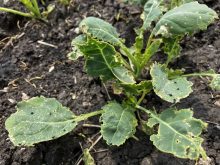End-users and regulators are literally putting your grain under the microscope, measuring residues in the parts per trillion. That puts the onus on farmers to deliver grain that meets their standards or risk rejection.
So, before applying inputs farmers should consult agri-retailers and grain buyers about what products markets are accepting and follow label directions on the inputs they use, Canadian grain industry officials advise.
“Before a product is used make sure that somebody’s not going to say ‘no’ when you drive the truck up to the elevator,” Cereals Canada executive director Cam Dahl said in an interview.
Read Also

Manitoba sclerotinia picture mixed for 2025
Variations in weather and crop development in this year’s Manitoba canola fields make blanket sclerotinia outlooks hard to pin down
Just because an input is registered in Canada doesn’t mean it has been approved everywhere.
That’s the case with Manipulator (chlormequat), a growth regulator registered in Canada last September for use on all types of wheat. Engage Agro, the company selling it here says Manipulator reduces wheat height, reduces lodging and boosts yield. But while chlormequat has been used in Europe for 30 years, it has not been approved yet for wheat in the United States, said Engage Agro product manager Tom Tregunno.
Since there’s no maximum level of residue (MLR) set for chlormequat in the U.S. for wheat, zero is the limit by default. As a result Canadian wheat containing traces of chlormequat could be rejected in the U.S.
“Farmers need to talk to their buyers ahead of time,” said Wade Sobkowich, executive director of the Western Grain Elevator Association, which represents Canada’s main grain companies.
“Knowledge is what we need when it comes to this and then we can plan our shipping accordingly.”
Policies about buying wheat treated by chlorme-quat or other inputs will vary among companies, by location, and even the time of year, Sobkowich said. Elevators that don’t normally export wheat to the U.S. might have few, if any, restrictions. Other elevators might decide to segregate the wheat while others might not buy it at all.
“If farmers talk to their elevator then they can decide whether they should use the product, or, if they do use the product, if they can deliver it,” Sobkowich said. “They can find out if they are inadvertently removing themselves from a potential market by using it or if it does not matter.”
Awareness of end-users’ concerns is not new. The Canola Council of Canada has warned farmers for years not to spray malathion in bins used to store canola.
Canada’s maltsters also don’t want farmers applying desiccants, including glyphosate, to malting barley.
But increasingly farm practices are under scrutiny, said Dahl, adding that it’s not all bad because Canada has a strong regulatory system and positive story to tell.
“So the impact of being outside the lines — whether those are technical lines or not — are greater,” he said. “And at the same time our ability to test (for trace substances) is significantly improving. We’re testing down to one part per trillion… when your tolerance is zero one part per trillion is not zero.”
Buyers’ concerns aren’t restricted to pesticides and plant growth regulators. Mycotoxins, some of which develop when grain is in storage, crop traits developed through genetic engineering or the adventitious presence of genetically modified crops can cause buyers to reject shipments.
Currently there’s no list of input residues importers have zero or low tolerances to in cereal shipments, but it’s something the grain industry and the federal government are working on, Dahl said.
Engage Agro has geared down its Manipulator spring sales program, given the product hasn’t been approved on wheat in the U.S. yet.
“If guys have question we will give them the information,” Tregunno said.
Seed growers are still potential customers because they sell their crop domestically for seed, instead of export.
“Obviously we’ve cut back on shipments into Canada so supply is relatively low relative to what we originally forecasted,” Tregunno said.
“We see a real fit in Manitoba where the yield potential is high and there are a lot of innovative growers that really want to push it.”




















